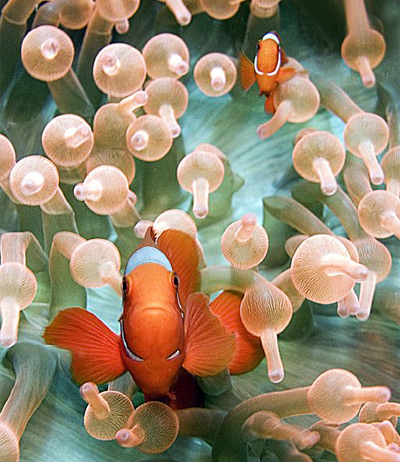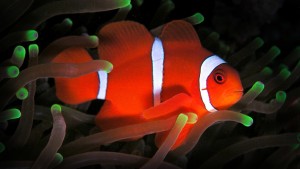Many of the clownfishes have a well-deserved reputation for feistiness. But there’s one clown that makes all the others seem like milquetoasts by comparison—the maroon clownfish (Premnas biaculeatus) from the Indo-West Pacific. Though it’s among the hardier and more strikingly colored clownfish species, P. biaculeatus definitely takes aggression to new heights, making tankmate compatibility the biggest issue in keeping this species successfully.
One of a kind
Of the 30 different clownfish species, 29 belong to the genus Amphiprion. The maroon clown gets the genus Premnas all to itself. It’s differentiated from all the Amphiprion clowns by the sharp spines on its gill covers, which give rise to another common name for this species—the spinecheek clownfish.
Physical traits
In addition to the aforementioned cheek spines, P. biaculeatus is red overall with three white to grayish vertical bands on its body—one just behind the head, one at mid-body, and another on the caudal peduncle (base of the tail). There’s also a variant with yellow bands, usually sold as the goldstriped maroon clownfish. P. biaculeatus exhibits marked sexual dimorphism, with females being significantly larger than males. Full-grown females can reach upwards of 6 inches, while males may achieve only about one-third of that size.
Feeding
The maroon clownfish will readily accept all manner of standard aquarium fare, including fresh, frozen, and dry items—mysids, chopped seafoods, frozen formulations, flakes, pellets, etc. Being omnivorous, this species should be offered a variety of both meaty and algae-based foods, and twice-daily feedings are recommended.
Housing
Minimum housing for a maroon clownfish is a tank in the ballpark of 30 gallons. However, if you want to keep one of these clowns with a variety of other fish, they would need to be sizeable and bold enough to stand up to the clown, so a much larger tank would be necessary in that case.
Tankmates

Generally speaking, smaller or similar-sized fishy tankmates are not an option for this hyper-aggressive clown. Bigger, more assertive species, such as larger wrasses, tangs, angels, triggers, etc., should be able to hold their own though.
Other clowns and conspecifics should also be avoided with the possible exception of mated pairs. If you want to try keeping a pair, it’s a good idea to provide either a tank divider or some other sort of retreat with an opening just large enough to admit the male while excluding the much-larger female. That way, the male can escape the female’s bullying if it becomes unrelenting.
Is an anemone necessary?
In nature, P. biaculeatus associates with Entacmaea quadricolor, the bubble-tip anemone. This species tends to do fairly well in captivity as anemones go, so setting up a tank that spotlights this symbiosis would certainly be an option. However, an anemone host is not necessary for keeping this or any other clownfish successfully in captivity.



